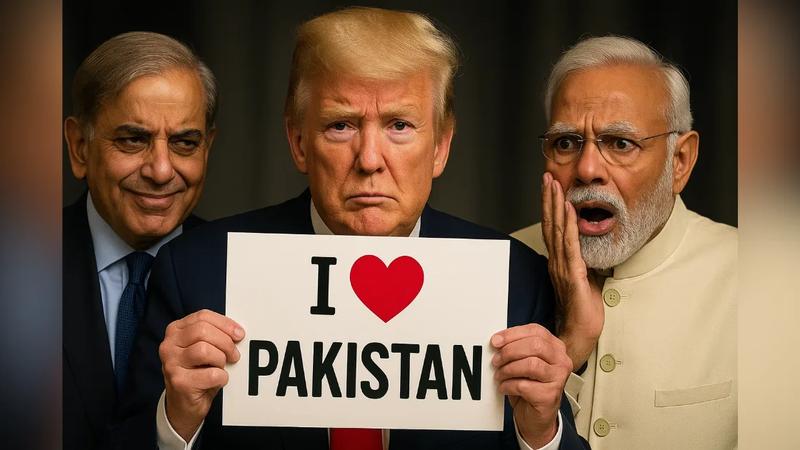The Trump Turnaround: Why India Must Rethink Its US Strategy

There was a time when Donald Trump openly called Pakistan a “terror haven.” That wasn’t too long ago.
Today, that same Donald Trump is eyeing massive investments in Pakistan’s gold mines.
Why the U-turn?
What changed, Mr. Trump?
And more importantly—should India be worried?
Chapter 1: From Condemnation to Collaboration
India once saw Trump as an ally. Someone who shared our stance against terrorism. Someone who wasn’t afraid to name Pakistan for what it was. But ever since Operation Sindoor, things have started to feel different. Uncomfortably different.
Trump’s actions now seem to favor Pakistan—economically, diplomatically, and even strategically.
Take this for example:
- The IMF handed Pakistan a $1 billion loan recently.
- Pakistan has begun attracting foreign investment in mining and real estate.
Ask yourself: What changed?
The answer in many circles is becoming increasingly obvious: Trump.
Chapter 2: The Gentry Beach Link
Enter Gentry Beach, a close confidante of Trump. This man has recently been on tours to Pakistan, Bangladesh, and Turkey—nations that don’t exactly top India’s list of strategic friends.
Beach met Pakistan’s Army Chief, Asim Munir, and promised American investment in gold mining near the Indus River. His exact words?
“America cares about Pakistan. You are our front face in this region.”
He even described Pakistan as a “misunderstood ally.” Really?
Here’s the catch—Beach isn’t just some businessman. He and Trump’s son went to the same college. ProPublica, a respected media house, has exposed Beach’s deep financial ties to Trump. The investments he makes? Many of them eventually fuel Trump’s campaigns.
So, when Beach says “billions will be invested in Pakistan,” we better believe Trump is involved—directly or indirectly.
Chapter 3: What’s in It for America?
Pakistan is sitting on $6 trillion worth of mineral reserves—but it doesn’t have the money or the infrastructure to extract them.
Who’s stepping in?
- America, via proxies like Gentry Beach.
- China, silently waiting in the background.
Let’s be clear: this investment is not about helping Pakistan’s economy grow. It’s about leveraging resources. It’s about strategic control. It’s about geopolitical chess, and Pakistan is the pawn.
America doesn’t mind. After all, a pawn is still useful—until it’s sacrificed.
Chapter 4: From FATF to IMF – The Flip-Flop
Remember 2018? When Trump was President and Pakistan was placed in the FATF Grey List for funding terrorism?
This single move hurt Pakistan’s ability to borrow money, receive aid, or conduct international trade. That was tough Trump.
Fast forward to today. Same Trump. But a different playbook.
After the Pahalgam attack, instead of condemnation, Pakistan gets $1 billion from the IMF. It’s like the punishment of the past never happened.
Chapter 5: What About India?
There was a time when Modi and Trump walked shoulder-to-shoulder at the Howdy Modi event in Texas. The crowd roared. The visuals were powerful.
But here’s what we’ve come to learn:
For America, “friendship” means access to your markets, your talent, and your resources.
It doesn’t mean loyalty.
It doesn’t mean security.
It doesn’t mean support during crises.
Trump warned Apple against manufacturing in India by threatening tariffs.
The official Washington stance is cold and clear:
“India and the United States will never be allies in the traditional sense of the term.”
That’s not a partnership. That’s a transaction.
Chapter 6: America’s Asia Strategy
Let’s decode this.
- India is a counterbalance to China.
- Pakistan is a counterbalance to India.
- Keep Asia busy with regional fights, and keep selling weapons to all sides.
This is America’s game plan.
They don’t want peace.
They want controlled chaos—far from their borders.
They want brown bodies on the battlefield while the military-industrial complex thrives.
Chapter 7: Why Pakistan Matters to the US
Think of two brothers:
- One is self-reliant, educated, globally respected.
- The other is broke, impulsive, and easy to manipulate.
Who would you exploit if you were a global superpower?
Exactly.
Pakistan is useful not because it’s strong—but because it’s easy to control.
It borders Iran, giving the US a launchpad for future plans.
It lacks money, making it dependent.
And it’s hungry for global recognition, making it vulnerable to flattery.
India? India’s independent. Too independent.
Which makes India less pliable—and less profitable.
Chapter 8: India’s Reality Check
Yes, Trump may return.
Yes, things will get more unpredictable.
But India is no longer naïve.
As Foreign Minister S. Jaishankar said:
“We’re not nervous about Trump’s return.”
Translation: We’re prepared. Whatever comes—economic shocks, diplomatic betrayal—we’re ready.
India needs to remember:
- We’re not part of NATO.
- We have no automatic defense guarantee.
- America watches from the sidelines in our conflicts.
Even during the Galwan Valley clash with China, America gave us intel, not intervention.
Conclusion: The Illusion of Friendship
Let’s stop calling America a friend.
Let’s call it what it is—a strategic player.
One who plays all sides for its own gain.
The truth is hard. But the sooner we accept it, the stronger we become.
“To be America’s enemy is dangerous.
To be its friend is fatal.” – Henry Kissinger
It’s time India charts its own path—with eyes wide open.